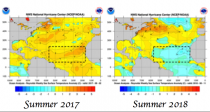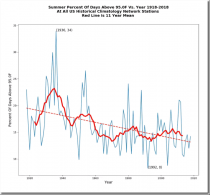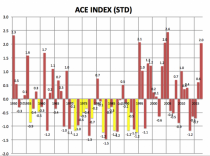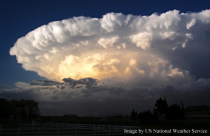Aug 30, 2018
Meteorological Summer
Dr. John Christy, Alabama State Climatologist
Meteorological summer (June, July and August) is now over and it’s time to check how the summer temperatures compare with other years. For a research project a few years ago we developed a statewide summer temperature index for four 100-mile diameter regions centered on the major cities of the state, Mobile, Montgomery, Birmingham and Huntsville going back to 1883. This summer will go down in that database and in NOAA’s official records as being slightly cooler than average.
Somewhat related to this, a reader sent me a link to a New York Times interactive website that claims to provide the number of days above 90F each year for cities across the country. The results are produced for the Times by an outfit (some might call it an environmental pressure group) called the Climate Impacts Lab.
Since I build numerous datasets of this type, I took a look. The website asks you for the town and year in which you were born, then provides a time series purportedly showing the number of 90F days per year since your birth and how that has increased.
Though a native of California, I have lived in Huntsville more years than any other place, so I put in my birth year and Huntsville as my hometown. Immediately I became suspicious when their dataset started only recently in 1960 (and a few years after my birth!) Evidently the Times and the Climate Impacts Lab don’t want to deal with folks older than 58.
For Huntsville and Montgomery, here are their results - kind of scary. It appears that the number of 90F days has risen to their highest levels ever. I’m told that in 1960 Huntsville had about 45 days above 90F but by 2017 it was 57 days and rising.

Enlarged

Enlarged
Then, to make matters even scarier, they use climate model projections to 2090 to tell me that when I’m “80” in 2040, there will be 73 such hot days in Huntsville as seen below. Yikes!

Enlarged
Before you sell your house and move to Canada, let’s take a look at the real story. Having built many climate datasets of Alabama, some starting as early as 1850, I knew the Times story was designed to create alarm and promote the claim that humans who use carbon-based energy (gasoline, natural gas, coal) to help them live better lives are making our summers ever more miserable. Be aware reader, this webtool is not designed to provide accurate information.
First of all, climate data for Alabama began in the 19th century, not 1960. In 2016 Dr. Richard McNider (Alabama’s former State Climatologist) and I published a carefully constructed time series of summer temperatures for the state starting from 1883 that utilized numerous station records, some that even the federal government had not archived into its databases (which is the most common source for outfits like the Climate Impacts Lab.) I’ve updated that work to include summer temperatures through 2018 - the result is below. Not only are summer daytime temperatures not rising, they have actually fallen over the last 136 years. Hmmm… after looking at the graph, why do you suppose the Climate Impacts Lab decided to start their charts in 1960?

Enlarged
We went a step further in that paper and demonstrated that climate models failed completely to replicate the downward temperature trend in Alabama over the past 120 years - 76 different models with a 100% failure rate. Would you trust these same models to tell you about the future as the Times does? Why did they not check the models for validity?
Now, what about the number of “hot” (or in Alabama we would say ‘typical") 90F days? For Alabama and the nation, I’ve calculated the average value per station each year since 1895. The results below speak for themselves (there is no increase of days hotter than 90F) and expose the misinformation provided through the Times.

Enlarged

Enlarged
Providing accurate information on Alabama’s climate is what we do in our office. In fact, using real data, I can’t even come close to reproducing the images that the Climate Impacts Lab did which show 2010’s as having the most 90F days in Alabama - I’m guessing they are using some theoretical output rather than sticking with observations. Notice how smooth their graph is compared to real data - it doesn’t look real to me. I’ll check and follow-up as I can, but something is fishy.
This is a great state in which people can enjoy life and in which businesses can operate - and our climate resources are one of the reasons we are doing so well in recruitment. Occasionally though the time comes when I must address claims made by those whose intention is not to inform but to promote false alarm - this usually happens when an environmental pressure group generates a press release whose dramatic statements are published by a willing media (without any fact-checking.) This is one of those times, and I’m sure it will not be the last.
Citation:
Christy, J.R. and R.T. McNider, 2016: Time series construction of summer surface temperatures for Alabama, 1883-2014, and comparisons with tropospheric temperature and climate model simulations. J. Applied Meteor. Climatology, DOI: 10.1175/JAMC-D-15-0287.1.
Data from the New York Times website accessed on 5 and 6 September, 2018.
Aug 29, 2018
The science that cried wolf
By Adam Piggott

Looks good to us.
An article today in The Australian concerning the imminent demise of the Great Barrier Reef and the exhortation that something must be done is interesting not for its bloated and deceitful content but for the comments that follow it. The writer, Ove Hoegh-Guldberg, is the director of something called The Global Change Institute at the university of Queensland.
“The Global Change Institute (GCI) at The University of Queensland is an independent source of innovative research, ideas, policy and advice for addressing the challenges of a changing world.”
In other words, do-gooders who managed to wrangle themselves sweet funding under the guise of ‘the end of the world is nigh!’ (Notice how you don’t see those crazy guys holding placards outside dusty train stations anymore? They’re all employed in the climate scam industry.)
The crux of the scaremongering in the article comes down to this bit:
“The changes are being driven by the climate, which is the reef’s most significant threat. The Great Barrier Reef Outlook Report, produced by the Great Barrier Reef Marine Park Authority, makes that clear, as does the Reef 2050 Plan, the overarching framework for protecting and managing it developed by the commonwealth and Queensland governments. It tells us that a lack of action on climate change will see our reef disappear, along with other vital ecosystems.”
Get that? The reef will disappear! (Waves arms and runs around in circles whilst making the boogy-man noise).
The comments that follow the article are uniform in their scorn and ridicule for the false message that the climate doomsters have been predicting for so long now. What a turnaround from just a few years ago when the majority of comments would have elicited tones of deep concern and shock that such a great tragedy was about to befall our nation and our world.
That’s what an increase of over 500% on domestic energy prices will do to your message of doom.
Scientists have sure been banging on for quite some time now about a variety of doomsday disasters caused by us human folk that somehow have all failed to materialize as predicted. We were going to run out of oil, copper, gold, gas and just about every other resource you could poke a stick at by the 1980s. The world was going to be consumed by horrible famines caused by overpopulation, while instead we’re now producing so much food that we’re using the leftovers to fuel vehicles. There was going to be a new ice age, then it was global warming, and finally they hit upon the singular brilliant tautology of climate change.
That last one is indeed true because the climate is not static. Way to go scientists; you got one right! (Not.)
There has been so much scientific bullshit that people are becoming somewhat inured to what so-called scientists claim. James Delingpole just doesn’t trust scientists anymore:
“It’s not science they distrust so much as scientists - especially ones in more nebulous, activism-driven fields like ecology or sociology. As Cofnas told Campus Reform, a site that exposes left-wing bias at universities: ‘Conservatives are right to be sceptical. Take any politicised issue that is connected to some disagreement about scientific fact. I do not believe there is a single case in the last couple of decades where a major scientific organisation took a position that went against the platform of the Democratic party.’ He added: ‘What an odd coincidence that “science” always, without exception, supports the liberal worldview.’”
The politicization of science, the substitution of scientody for scientistry, is in of itself inherently unscientific as it relies on some sort of left-leaning democratic process. To get ahead in this rigged game, people pretending to be scientists have to make things up. How else can one explain the appalling revelation that less than 50% of scientific studies can be replicated.
“Six such projects, including the SSRP, have now been completed. Between them, they’ve successfully replicated just 87 out of 190 studies, for an overall rate of 46 percent.”
No doubt many of these bogus studies were cited in peer-reviewed journals and used to badger dim and corrupt politicians into squandering the resources and wealth of their countries into placating the great climate god Ghia.
But the people aren’t believing it anymore. I’ve been bashing heads with climate change idiots online and in real life for over 10 years, but the turnaround in attitude that we’re now seeing really does underline the fact that the general public isn’t buying it anymore.
Which is too bad for science. You can only cry wolf so many times before the public no longer believes you. And if then a real calamity should present itself, a calamity that only science could identify, predict or solve; what then?
Science. Just one more part of our civilization that the prog army of darkness has successfully destroyed.
Aug 26, 2018
Then the rains came
Joseph D’Aleo, CCM
THEN THE RAINS CAME
It has been a changeable and at time extreme spring and summer. The cold and snow of March gave way to a cold April and some very chilly days well into the spring. Warmth with some very hot days followed in the early to mid summer. Then the rains came with strong thunderstorms. The wet August spell put an end to a borderline droughty spell the last few years. It became very muggy, keeping nighttime temperatures up and air conditioners on.
The changes all have to do with the wind direction. The jet stream brought chilly air masses (and snow) into eastern Canada even into June. The winds around these cool air masses turn to the northeast here in New England coming in off cool land and water. Then increasingly warm air masses built north into the Canadian prairies and came east. The surface winds turned northwesterly. In summer, warm air crossing the Appalachians and sinking down into the Merrimack Valley and coast heats by compression 5F or more. Our hottest days come with these ‘downslope winds’. Historically all the 100F days come with a west to northwest wind.
When late July and August came, our surface winds turned southwesterly.
This change was caused by a sharp cooling of the subtropical Atlantic Ocean waters relative to 2017.

Enlarged
The Atlantic cool subtropical pattern leads to that stronger than normal Atlantic high pressure called the ‘Bermuda High’. In these patterns, this regular feature of our climate expands south and west and acts as a pump for moisture much like we see in the southeastern and eastern Asia monsoon flow. This causes nights to be warm and muggy, and days very warm and showery here in the east.
Uncomfortable yes, unprecedented heat no. You may be surprised that most of the extreme heat records for the region, country and world occurred in the early 20th century or earlier. The 1930s was the record decade in the United States as a whole. For the east, the 1950s was the warmest but extreme heat has occurred even in cold periods.
July 1911 was an incredible hot month in the northeast with the northwest wind coming off a warm dry Canada where prairie fires reigned. Read about it on the New England Historical Society site here.
For the region and nation (all stations) the number of 90, 95 and 100F all continue the downtrend since the 1930s. Nights are warmer thanks to the fact most observations are now in urban centers or airports, which hold the daytime heat.

NOAA USHCN (Heller) Enlarged
EFFECT ON THE HURRICANE SEASON
As a general rule, when the subtropical Atlantic is warm, we have more hurricane activity, when it is cool, we have fewer storms. A measure of how much tropical activity energy there was over the season is the ACE (Accumulated Cyclone Energy) Index. See how last year when the subtropical Atlantic was very warm, ranked behind only 1893, 1926, 1933, 1995, 2004 and 2005 in total storm energy (and impact).. It featured major hurricanes that slammed the islands, Florida and Texas.

Enlarged
With the sub-tropical Atlantic cold this year and El Nino trying to come on in the Pacific, it is likely we will have a quiet year with fewer named storms and less than half the storm energy than last year. See all the cool Atlantic year shown in yellow (most in the 1970s to early 1990s).

Enlarged
Jul 30, 2018
Environmentalist scare stories - Never mind!
Paul Driessen
Solid evidence shows there is no “bee-pocalypse,” but alarmists allege new pesticide threats
“Baby boomers” will remember Gilder Radner’s Saturday Night Live character from the ‘70s - Emily Litella, who would launch into hilarious rants against perceived problems, only to discover that she had completely misconstrued what she was fuming about.
“What’s all this fuss about endangered feces?” she asked in one. “How can you possibly run out of such a thing?” Then, after Jane Curtain interrupted to tell her “It’s endangered species,” she meekly responded with what became the iconic denouement of the era: “Ohhhh. Never mind.”
The Sierra Club and “invertebrate-protecting” Xerces Society recently had their own Emily Litella moment, over an issue they both have been hyperventilating about for years: endangered bees. For over half a decade, both organizations have been raising alarms about the imminent extinction of honeybees and, more recently, wild bees - allegedly due to the widespread use of neonicotinoid pesticides.
These are advanced-technology crop protection compounds, originally developed and registered as “reduced-risk” pesticides. Applied mostly as seed treatments, neonicotinoids get taken up into the tissue of crop plants, where they control pests that feed on and destroy the crops, while minimizing insecticide exposure to animals, humans and beneficial species like bees.
But not according to the Sierra Club! It campaigned incessantly for years on the claim that neonicotinoids would drive honeybees into extinction. For instance, in March 2015 the Sierra Club of Canada launched a nationwide “Protect the Pollinators Tour,” as part of its #SaveTheBees project.
“Ironically, the justification for this chemical madness is the same desire to produce enough food to feed everyone,” it said. “The chemical industry wants us to believe we have no choice; it’s their way or the highway. But the science tells us otherwise - that farmers don’t need these chemicals at all! The science also tells us we’re not just killing bees and pollinators, but other insects too. And we’re also killing birds and aquatic life. The scientists tell us we could be creating a Second Silent Spring. It’s madness.”
A year later, the Maryland Sierra Club did its own fulminating, urging the state’s legislature to pass a “Pollinator Protection Act. “Help STOP Pollinator Deaths from Neonic Pesticides!” it exhorted.
“Toxic Neonic pesticides kill and harm bees and other pollinators, like butterflies and birds. Continued, unchecked use poses a serious threat to our food supply, public health and environment. Ask lawmakers to help keep Maryland pollinators safe and healthy - by curbing consumer use of toxic pesticides.”
In December 2016, the Sierra Club was out raising more money by sounding phony alarms about Trump appointees “denying the science” that supposedly links neonic pesticides to alleged bee declines:
“Bees had a devastating year. 44% of colonies killed.... And Bayer and Syngenta are still flooding our land with bee-killing toxic ‘neonic’ pesticides - now among the most widely used crop sprays in the country. Now, Myron Ebell - Donald Trump’s pick to lead the EPA transition team - denies the science that links neonics and bee death...”
Why would they make such false claims? Well, as Sierra Club officer Bruce Hamilton once admitted: “It’s what works. It builds the Sierra Club. The fate of the Earth depends on whether people open that envelope and send in that check” (or click on the ever-present online Donate Now button).
However, a few weeks ago, a Sierra Club blog post started singing a different tune:
“Save the bees’ is a rallying cry we’ve been hearing for years now… But honeybees are at no risk of dying off. While diseases, parasites and other threats are certainly real problems for beekeepers, the total number of managed honeybees worldwide has risen 45% over the last half century. ‘Honeybees are not going to go extinct,’ says Scott Black, executive director of the Xerces Society. ‘We have more honeybee hives than we’ve ever had, and that’s simply because we manage honeybees.
Conserving honeybees to save pollinators is like conserving chickens to save birds ... [since] honeybees are not all that different from livestock.”
So, Never mind. Finally, after all these years, the Sierra Club (and Xerces Society) admit that honeybees are not going extinct. It would appear as well that neonic pesticides can’t be causing a honeybee apocalypse - because there isn’t one!
But in the eco-alarmism world, every silver cloud has a dark lining! This time, it’s wild bees, also called “native” bees, whose allegedly looming demise is the imminent ecological cataclysm du jour.
Honeybees are not native to North America; they were first brought here by colonists in 1622. Now - according to the Sierra Club anyway - these non-native bees pose a threat to wild bees and other native pollinators. New research, it says, “shows managed honeybees can negatively impact native bees.”
Varroa mites, deformed wing virus and other problems from commercial hives (the real causes of honeybee declines in recent years) “can be transferred to wild species when populations feed from the same flowers.” In fact, the rusty patched bumblebee, “which was listed as endangered in early 2017 after declining more than 90 percent over the last decade, may owe that disappearance to diseases spread by commercial bees.” And the RPB is not the only threatened or endangered wild bee species.
Many native bees - of which there are over 20,000 species globally, in various sizes, shapes and colors - “are experiencing incredible losses,” says a Sierra Club blog. “Of the nearly 4,000 native bee species in the United States alone, four native bumblebee species have declined 96 percent in the last 20 years, and three others are believed to have gone extinct. In the last 100 years, 50 percent of Midwestern native bee species disappeared from their historic ranges.”
Now the blog doesn’t claim all these supposed wild bee declines are due to neonic exposure. At least it doesn’t say so just yet, leaving that inference to your imagination. However, the Sierra Club is likely just as wrong about wild bee species being in trouble, as it was during its previous years of railing about the causes and reality of honeybees going extinct.
First, the overwhelming majority of wild bee species, at least in North America, never get any exposure to neonicotinoid pesticides, because they are desert species ‘ with habitats typically tens or hundreds of miles away from croplands.
Second, the overwhelming majority of those wild bee species are specialists. They feed exclusively on the pollen and/or nectar of one or a very few plant species ‘ and their life-cycles are tied inextricably to the flowering cycle of the (mainly desert) plants they pollinate.
They typically emerge from the ground prompted by the same natural signals (rains) that awaken the cacti and other plants. They then live just long enough to produce larvae and stock the larval nests with food (pollen and/or nectar) from the plants they pollinate before they die. This cycle is completed in days - and pesticide exposure is virtually impossible given the environments where it takes place.
All this is not to say that wild bees don’t play any role in crop pollination. Some do.
However, 59 scientists published a three-year study in Nature, concluding that only 2% of wild bee species provide “almost 80% of the wild bee crop pollination.” They also found that “the species currently contributing most to pollination service delivery are generally regionally common species, whereas threatened species contribute little, particularly in the most agriculturally productive areas.”
In other words, the handful of wild bee species that contribute the lion’s share of wild bee crop pollination - and thus are most exposed to neonic and other pesticides - are abundant and not threatened or at risk, certainly not from pesticide exposure.
This jibes with the observations by Sam Droege, the U.S. Geologic Survey’s wild bee expert whose surveys indicate that most wild bee species are doing just fine.
It’s encouraging that the Sierra Club and Xerces Society have finally acknowledged that the “honeybee apocalypse” - which they used for years to demonize neonic manufacturers and raise millions of dollars - was pure fiction. Eventually, perhaps, we hope (fat chance) they’ll admit their exaggerated claims and half-truths about wild bees are equally phony and misleading.
It’s a real pity that so much public hysteria - and pressure on politicians and regulators to combat fictitious bee problems - was generated in the process. That was especially true in Europe, where regulators gave in to agitator pressure and misrepresentations, and banned neonics this year. Now farmers will have to spray crops with pesticides that really are harmful to bees, or will lose more to voracious insects.
Environmental activists always claim to be pushing for better public policies, to “Save the Earth.” Misdiagnosing and misrepresenting non-existent ecological crises is precisely the road to the hell of bad public policy. And it’s not always paved with good intentions.
At least when it comes to claims about another “bee-pocalypse,” it’s time to say, Never mind.
Paul Driessen is the author of Eco-Imperialism: Green power - Black death and other books and articles on energy, climate change and environmental activism.
Jul 05, 2018
“Contributing to” - Foolish Words in the Climate Change Debate
By Steve Goreham

Originally published in World Net Daily.
Earlier this month, The New York Times featured an article titled “Hockey in the Desert.” The article concluded that by building a hockey stadium in Las Vegas, the National Hockey League was contributing to climate change. The phrase “contributing to” is used over and over by political leaders and the media to voice concern about human-caused global warming, but “contributing to climate change” is a meaningless phrase.
In his address at Georgetown University in June of 2013, President Barack Obama stated, “...the planet is warming, and human activity is contributing to it.” In 2011, New Jersey Governor Chris Christie said, “...climate change is occurring and that humans play a contributing role...” In Congressional confirmation hearings, Energy Secretary Rick Perry affirmed that man-made activity was contributing to climate change.
Every human activity contributes to climate change. If you have a housecat, it “contributes to” climate change. As we burn sugars in our body, we produce carbon dioxide (CO2). Every time you exhale, you breathe out 100 times the concentration of CO2 in the atmosphere. The real question is “What is the size of human contribution compared to natural factors?”
Earth’s climate is amazingly complex. It’s driven by gravitational forces of our solar system, radiation from the sun, and cosmic rays from stars in deep space. Climate is a chaotic, interdependent system of atmosphere, biosphere, ocean, and deep oceans. Climate has been changing through cycles of warming and cooling, tropical ages, temperate ages, and ice ages throughout all of Earth’s history. Climate change is not only real, it’s continuous.

Enlarged
Energy from the sun drives all weather on Earth. Sunlight falls directly on the Equator and Tropical Regions, where much energy is absorbed. Sunlight falls indirectly on Polar Regions. All elements of Earth’s weather, storm fronts, hurricanes, the jet stream, and even ocean currents, are driven to redistribute energy from the tropics to the poles.
The oceans have a powerful effect on Earth’s climate. The Gulf Stream current in the Atlantic Ocean dominates weather and temperatures in Europe. The El Nino cycle in the Pacific Ocean affects weather all over the world. The oceans have 250 times the mass of the atmosphere and can hold more than 1,000 times the heat.
Aerosols are an important factor in Earth’s climate. Dust from volcanos, desert dust, and pollen from plants rise into the atmosphere and influence the climate. Yet today’s climate scientists are obsessed with the level of atmospheric carbon dioxide, a small part of the overall picture.
Carbon dioxide is a trace gas. Only four of every 10,000 molecules in our atmosphere are CO2 and the amount that human industry could have added over all of our history is only a fraction of one of those four molecules.
Earth’s greenhouse effect, the capture of outgoing infrared radiation by greenhouse gases in the atmosphere, is said to be strengthened by emissions from industry and is blamed for human-caused global warming. But even the greenhouse effect is dominated by natural factors. Earth’s dominant greenhouse gas is neither carbon dioxide nor methane. Water vapor is Earth’s dominant greenhouse gas. Somewhere between 70 and 90 percent of the greenhouse effect is caused by water vapor and clouds.
Even the majority of the carbon dioxide in our atmosphere was placed there by nature. The oceans hold 50 times as much carbon dioxide as the atmosphere and the oceans are continuously releasing CO2 and absorbing CO2. When plants die, they release carbon dioxide, and they absorb CO2 when they grow. Volcanos above the surface of the ocean, and about ten times as many under the surface of the ocean, continuously emit CO2 and other gases into the environment.
Every day, nature puts about 20 times as much carbon dioxide into the atmosphere as all of human industry, and removes about the same amount. If we halted all industrial CO2 emissions, we probably could not measure a change in global temperatures.
Political leaders and newscasters, understand that the phrase “contributing to climate change: is meaningless, so please try to use something a little more intelligent.
Steve Goreham is a speaker on the environment, business, and public policy and author of the book Outside the Green Box: Rethinking Sustainable Development.
|















